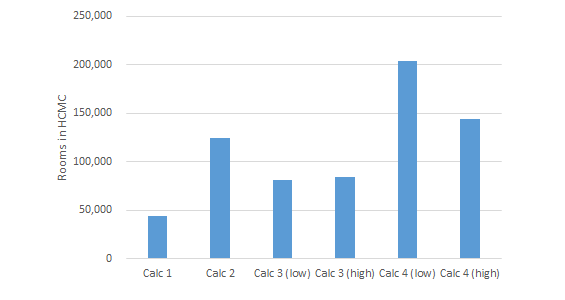Hotels: A market-sizing exercise (part 7 of ???) [Updated 5 Feb*]
/Eventually, I have gotten back to looking at the hotel business in Vietnam. I wanted to focus on Ho Chi Minh City and Hanoi over the next few posts, because I think we are going to see lots of investment in these two cities. Then there are a few others that are tourist hubs, like Pho Quoc, Da Nang, Nha Trang, and Hoi An which may also be worth looking into, at least cursorily.
I started with Ho Chi Minh City (HCMC) because it has the largest number of tourists, almost 7.5m foreign tourists in 2018 and 29m domestic travelers. There are no good stats on how many hotel rooms there are in HCMC, so my first step is to try to come up with a figure of hotel rooms. I have a few statistics around the figure. First, in 2016, the Vietnamese Department of Tourism said there were 2,200 hotels in HCMC. We also know how many hotels there were in 2015 in all of Vietnam: 355,000, also according to the D of T. And we have the number of upscale and luxury hotel rooms in the city, 10,174 in 2014, according to HVS, a hospitality consultancy.
This is an important point to make - when doing market sizing, most of the time you don’t have the number you actually want, but you have a bunch of numbers that allow you to make some calculations and test them out.
SOURCE: VIETNAMESE DEPARTMENT OF TOURISM, VIETECON.COM
Calculation 1: Using hotels to estimate rooms: For the country as a whole, based on figures I have from 2000 to 2015, there were on average 20 rooms per hotel. If I use this and multiply by the 2,200 hotels, then I get 44,000 rooms, which is way too low, even for 2014 (as you will see in a minute).
SOURCE: VIETNAMESE DEPARTMENT OF TOURISM, VIETECON.COM
Calculation 2: Using the number of hotel rooms in the country as a whole (355,000), let’s assume that HCMC has a portion based on the percentage of foreign and domestic tourists it garners. So in 2015, there were 7.9m foreign visits in Vietnam of which 4.6 came to HCMC, or 58%. Domestic tourists to HCMC were only 30% of the total of all in the country. If I weight foreign and domestic tourists equally, then the percentage would be 33%, but if we double the weight of foreigners, because they generally stay 2x as long, then we get 35%. That would equate to 124.250 rooms, which may be more accurate.
SOURCE: VIETNAMESE DEPARTMENT OF TOURISM, HVS, VIETECON.COM
Calculation 3: Using the figure for upscale & luxury hotel rooms in HCMC of 10,174 in 2014, let’s use the same percentages reported for the full market to reach a figure for total hotel rooms in HCMC. In 2014, 5-star hotel rooms were 5.3% of the total, 4-star were 6.8%, and 3-star were 8.0%. HVS doesn’t tell us what they mean by “upscale & luxury” but I would assume 4- and 5-star. Of all rooms in Vietnam, 12.1% were of this grade. Taking that would imply that there were 84,000 hotel rooms in Vietnam. We also have a figure for 4-star and 5-star rooms in 2018. According to the HCMC Tourism Department, there are 6,257 5-star and 3,500 4-star hotel rooms, or 9,757 in total. That would mean only 80,500 hotel rooms.
BLUE = ESTIMATES. SOURCE; VIETNAMESE DEPARTMENT OF TOURISM, VIETECON.COM
Calculation 4: Work from the number of guests and occupancy rates to come up with the number of hotel rooms. First, we take the number of foreign guests, of 7.5m in 2018. Then assume they stay 5.21 nights per stay (this is based on this story, it’s for 2017, but let’s assume it is the same for this year). And then I assume there are 1.5 guests per room. That means the 7.5m foreign tourists stay 38.9m nights but take up 25.9m room nights.
Let’s do the same for domestic travelers. There were 29m of them in 2018, and I assume only 50% stay overnight. Based on the same survey as for foreign tourists, they reportedly stay 3.6 nights per visit (which seems high to me). And again, 1.5 of them stay per hotel room. That means of the 29m domestic travelers, only 14.5m stay overnight, but they stay a total of 52.2m nights, equating to 34.8m rooms used.
Let’s combine these two figures to reach 60.7 room nights, and assume that hotels had an occupancy of 70%, that means there needs to be 238,000 hotel rooms to accommodate all of these visitors. This figure is so much higher than the results of my other caulciatons, I am a bit worried.
If I make some changes here, say that foreigners only stay 5 nights, and that domestic travelers only stay 2.5, plus assume that the hotels are at 80% occupancy, we reach a total of 168,000 rooms needed. This is also much higher, but more realistic.
SOURCE: VIETECON.COM
Conclusion: We have four different estimates of total hotel rooms. The estimates go from a low of 44,000 to a high of 238,000. Some of these are different years, but even so, the range is extremely high. Out of the four calculations that seem most logical to me are calculations 2 (124,250 hotel rooms in 2015) and 4 (144,007 in 2017). Those are close to each other and use assumptions (e.g., 35% of all hotel rooms are in HCMC) that are reasonable.
Tomorrow, I will use these two calculations to come up with estimates throughout the time period and get to a figure of what were the total number of hotel rooms since 2000. Then on Wednesday, I’ll take you dear readers into the future.
*Updated to add calculation tables and final chart.






